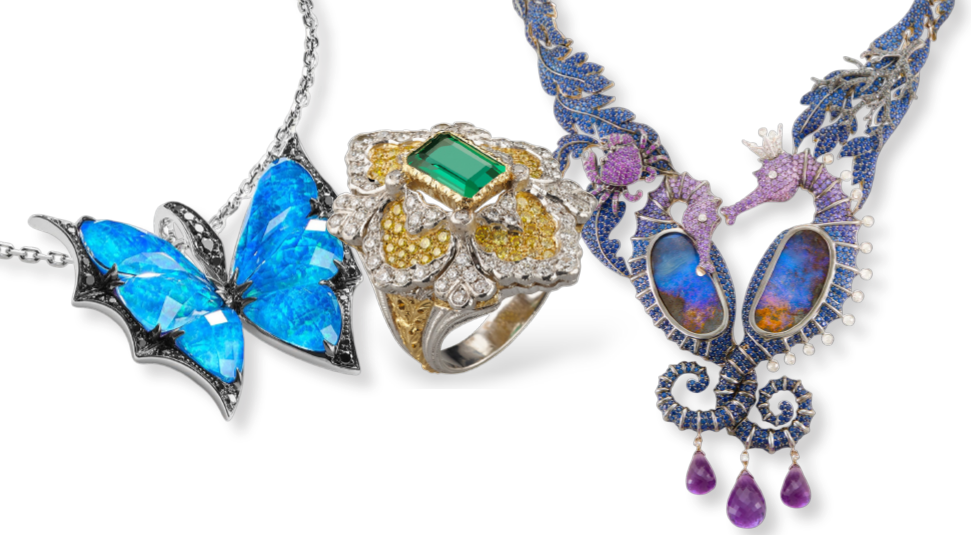The jewellery industry has long been known for its complexity and demanding nature. For many, it is defined by long hours at the bench, challenging custom orders, and discerning customers.
Over the past two decades, the demand for custom-made jewellery and services, such as repairs, has steadily increased, with a specific spike during the COVID-19 pandemic noted. With an ageing workforce and an inadequate number of jewellery apprentices entering the industry each year, the trade struggles to meet this demand. Earlier this year, a report noted that three to four weeks is considered an acceptable turnaround time for completing and delivering a newly designed and manufactured jewellery item.
An industry survey found that around one-third (34 per cent) of respondents were willing to concede that they were unable to meet this industry benchmark three years ago.
Unfortunately, it was clear that the situation had worsened, with 63 per cent of respondents indicating that this work cannot currently be completed within four weeks for customers.
With that in mind, it is not surprising to learn that an increasing number of jewellers are experimenting with emerging technologies and incorporating new tools into their business. Indeed, scientific and technological progress has transformed many retail industries, and the jewellery trade is no exception.
Few innovations have had as significant an impact as Computer-Aided Design (CAD) and Computer-Aided Manufacturing (CAM). As many retailers have told Jeweller, CAD/CAM technology is capable of unlocking seemingly limitless design possibilities.
For some, it opens the door for the creation of pieces that were once thought impossible. These tools enable jewellers to produce high-quality pieces more efficiently and at a lower cost.
As a consequence, high-end and custom-made jewellery isn’t restricted to elite designers and brands with exhaustive resources. Skilled jewellers can now deconstruct complex designs into individual components, streamlining production and finishing while maintaining exceptional standards.
Indeed, these jewellers no longer have to feel daunted by intricate designs that would once take many agonising weeks and even months to make by hand. In many ways, the ultimate beneficiary is the consumer, who wins access to dreamy jewellery at a price that doesn’t crush the budget.
With that said, these forward-thinking jewellers also enjoy the benefits of not only another happy customer, but also an improved reputation in their respective market.
 |
| Oat & Field Star by Chaumet | Celustun by Cartier |
The Past
Two years ago, Jeweller spoke with several retailers about the transformative impact CAD/CAM has had on their business. Among them was designer and gemmologist Maria Kostina.
She is the owner of Maria K Jewellery in Sydney. She said that the ability to work closely with customers during the design process was valuable.
“Nothing beats showing your customer the piece during jewellery design - 2D drawings are great, of course; however, sometimes they can be misleading,” she explained.
“With CAD, you could show the design through realistic renders and also 3D print the model for the customers to try on. This way, the customer knows what to expect, and even those particularly fussy customers can be satisfied.”
Another contributor to that report was Eric Kojadelian of Vahe Jewellery in Victoria, who explained the significance of technology in manufacturing as a younger jeweller.
“I’m a firm believer in the importance of CAD/CAM and 3D printing in our trade. It really is the way to go, at the end of the day, you can accomplish so much that you can’t do by hand,” he said.
“When my father introduced me to the business, he told me on day one that the days of doing things by hand are over.
“I would say the most significant benefit of working with CAD/CAM and 3D printing technology is having the ability to produce things I simply wouldn’t be able to by hand. However, at the end of the day, I just don’t think you can turn a profit by spending more than 40 hours each week hand-crafting a complex ring.
“As my father told me, those days have come and gone.”
These sentiments were echoed by Carlo Romeo of Carlo Romeo Jewellers in Western Australia. He has worked with jewellery since the 1980s and has found immense success using 3D imaging to provide consumers with the opportunity to review pieces before they are created.
“The most important benefit of working with these technologies is the increased speed and reduction in time spent completing a project from start until finish,” he explained.
“We can show our customers a life-like render as well as photos before the final product is made. This increases the chances that they’ll be happy when all is said and done. CAD/CAM and 3D printed jewellery are definitely higher quality, and importantly, when it comes to the gemstones, you get the added benefit of accurate measurements.
“The other major benefit worth remembering is the waste reduction that we find with manufacturing with 3D printing compared with hand-made work. I think that’s something everyone agrees is a positive.”
The Present
Two years later, Jeweller spoke with Romeo about the evolving significance of CAD/CAM in his business. He highlighted the record-high price of gold as another driving factor in the value of these tools and services.
“CAD has now become the norm, as it’s an expectation that customers can see the final product before we commence the manufacturing,” he explains.
“It also gives us the ability to quote the job correctly, and with the price of gold today, this has become more important.”
Flying from one coast to the other, the staff at Fairfax & Roberts spoke highly of the impact CAD/CAM has had on their business, based in Sydney. Joshua Rogers stated that these tools introduce a higher degree of flexibility to each project.
“CAD is a very important tool for our business. Most of our pieces are still handmade; however, CAD allows us the opportunity to see pieces in 3D before committing precious metal and manufacturing time to a project,” Rogers reveals.
“We’re able to then optimise the designs before handmaking the piece. It is also an extremely helpful tool for the bespoke side of our business.
“We invested in a 3D printer a few years ago, which, together with CAD, has allowed us to print designs in resin for our clients to see and try on in 3D before having the piece made in gold or platinum. We have found this to be extraordinarily successful and popular with most of our customers.”
Romeo also noted that over the past two years, advancements in CAD/CAM software have proven invaluable to his business. With the rising cost of gold, precise planning is essential.
Improved technology allows for greater accuracy in design and production, helping to minimise waste and maximise efficiency.
“The techniques really haven’t changed much in the last few years, other than improvements in the software provide us with more options and speed in the design stage,” Romeo explains.
“As I mentioned, the additional library of features provided with the more recent upgrades speeds up the process and allows us to provide more options to the customer, and the more accurate weight of gold provides us the ability to cost a job out more accurately.”
For many jewellers, CAD has become an essential part of the design process, offering creative freedom while also enhancing production efficiency. By enabling quick design modifications and accurate visualisation before manufacturing begins, CAD streamlines the workflow.
These tools can also ensure consistency, mainly when producing multiple identical components, something traditional handmaking struggles to achieve.
“We use CAD mostly as a design tool. CAD allows us the flexibility to make an unlimited number of changes to any design and offers the opportunity to see multiple versions of the same design before manufacturing anything in metal,” Rogers says.
“CAD also allows for reliable repeatability in a way handmaking never can when manufacturing identical components.”
 |
| Crystal Haze Pendant by Stephen Webster | Opera High Jewellery Ring by Buccellati | Deep Sea Necklace by Lydia Courteille |
The Future
As previously noted, industry research published earlier this year highlighted the increasing pressure faced by local jewellers attempting to cater to the surging demand for custom-made pieces.
That same report unsurprisingly found that almost all (96 per cent) of respondents anticipate the need to provide substantially more hours of jewellery manufacturing services in the next 12 months.
Looking ahead to the next three years, 70 per cent of respondents forecast a need for 20 hours or more per week of manufacturing services.
Facing these demand challenges, it seems inevitable that jewellers will continue experimenting with emerging technologies.
Rogers says that a recent trip to Hong Kong provided an opportunity to witness the ‘cutting edge’ of the trade.
“We have just returned from the Jewellery and Gem WORLD in Hong Kong and what I can confidently say is, the industry is embracing new technologies every single day,” he explains.
“Most of these new technologies require the use of CAD/CAM.
“In addition, with the rapidly increasing prices of precious metals, a lot of manufacturers, including our business, are investigating alternatives for our customers.
“These alternatives almost demand the use of CAD/CAM.”
Of course, it’s important to recognise that not every jeweller shares the same experience, and not all customers are drawn to technology-driven production. For many, the timeless allure of a hand-crafted, one-of-a-kind piece still holds value.
This enduring appreciation ensures there will always be a place for traditional craftsmanship within the industry. Some jewellers will continue to meet that demand, preserving the skills and methods passed down through generations.
However, for many others, a shift is undeniably underway. The jewellery landscape has evolved dramatically, from hand-drawn sketches and physical prototypes to sophisticated digital renderings and 3D-printed models.
Advancements in technology, particularly in CAD/CAM and 3D imaging, have streamlined the design and manufacturing process, offering jewellers increased precision, efficiency, and creative freedom.
Given the many advantages these tools provide, including faster turnaround times, cost-effectiveness, and the ability to customise designs with ease, it’s clear that digital innovation is more than just a trend.
For an increasing number of jewellers, it represents the future of the trade, complementing rather than replacing traditional techniques, and reshaping how jewellery is imagined, created, and sold.
READ EMAG